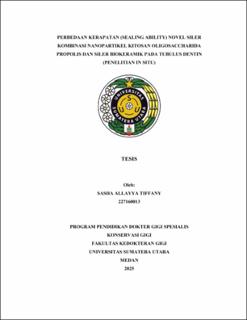| dc.contributor.advisor | Abidin, Trimurni | |
| dc.contributor.advisor | Prasetia, Widi | |
| dc.contributor.author | Tiffany, Sasha Allayya | |
| dc.date.accessioned | 2025-05-27T08:01:33Z | |
| dc.date.available | 2025-05-27T08:01:33Z | |
| dc.date.issued | 2025 | |
| dc.identifier.uri | https://repositori.usu.ac.id/handle/123456789/104147 | |
| dc.description.abstract | Background: Root canal treatment is intended to eliminate bacterial infection within the root canal system and prevent subsequent reinfection. Chitosan and propolis are natural substances that have demonstrated significant potential in medical applications, particularly as endodontic sealer materials, due to their antimicrobial properties and biocompatibility. The utilization of chitosan oligosaccharides and propolis in nanoparticle form is anticipated to improve sealing capability and enhance penetration into dentinal tubules, which can measure up to 500 nanometers in diameter.
Objective: To analyze the difference in sealing ability between a novel sealer combining chitosan oligosaccharide-propolis nanoparticles and a bioceramic sealer in terms of penetration into dentinal tubules.
Methods: This study used a laboratory experimental method, with material characterization tested using a Confocal Laser Scanning Microscope (CLSM) to observe sealer penetration ability. The tested sealers were a novel sealer combining chitosan oligosaccharide-propolis nanoparticles and the bioceramic sealer Ceraseal.
Results: The results showed that the sealing ability of the novel chitosan oligosaccharide-propolis nanoparticle combination sealer was not statistically significantly different from that of the bioceramic sealer Ceraseal, which is the current gold standard sealer.
Conclusion: This study concludes that the novel sealer combining chitosan oligosaccharide–propolis nanoparticles exhibits sealing ability comparable to that of bioceramic sealer. Evaluation using Rhodamine B dye and confocal laser scanning microscopy (CLSM) showed that both sealers penetrated dentinal tubules effectively. Although the bioceramic sealer group had a slightly higher average penetration intensity (106.23 ± 38.06) compared to the novel nanoparticle sealer (74.94 ± 19.75), statistical analysis revealed no significant difference between the two groups (p > 0.05). | en_US |
| dc.language.iso | id | en_US |
| dc.publisher | Universitas Sumatera Utara | en_US |
| dc.subject | Endodontic sealer | en_US |
| dc.subject | Nanoparticles | en_US |
| dc.subject | Bioceramic | en_US |
| dc.subject | Sealing ability | en_US |
| dc.subject | Chitosan-propolis | en_US |
| dc.title | Perbedaan Kerapatan (Sealing Ability) Novel Siler Kombinasi Nanopartikel Kitosan Oligosaccharida Propolis dan Siler Biokeramik pada Tubulus Dentin (Penelitian In Situ) | en_US |
| dc.title.alternative | The Difference in Sealing Ability of A Novel Sealer Combining Chitosan Oligosaccharide Nanoparticles and Propolis With A Bioceramic Sealer on Dentin Tubules (An in Situ Study) | en_US |
| dc.type | Thesis | en_US |
| dc.identifier.nidn | NIDN8985600020 | |
| dc.identifier.nidn | NIDN0013028005 | |
| dc.identifier.nidn | NIM227160013 | |
| dc.identifier.nidn | KODEPRODI12703#Konservasi Gigi | |
| dc.description.pages | 103 Pages | en_US |
| dc.description.type | Tesis Magister | en_US |
| dc.subject.sdgs | SDGs 9. Industry Innovation And Infrastructure | en_US |


